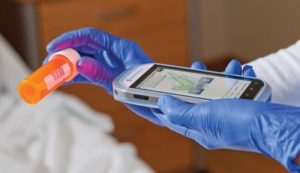 Evaluating Mobile Devices for Healthcare
Evaluating Mobile Devices for Healthcare
When evaluating new mobile devices for your healthcare staff, there are several factors to take into consideration. Selecting the wrong device can frustrate users, decrease productivity, increase costs and potentially introduce safety risks. Pick the right device and you’ll experience maximized workforce productivity, task accuracy and a higher return on investment (ROI). So, how do you make sure you’re picking the right device?
Consumer, Enterprise or BYOD?

As with every decision in life, there are going to be pros and cons. At first glance, consumer devices like iPhones, Android phones or tablets seem very appealing. Everyone already knows how to use them, enjoys using them, and they’re relatively affordable. However, consumer devices are just that. Designed for consumers. They’re not designed for an enterprise or work environment. Screens can break or crack easily, the technology is refreshed frequently, and they will not hold up to common cleaning agents found in the hospital – which is important when it comes to infection control. They have a high replacement rate and just aren’t designed to last that long. One year is typically the maximum time a specific model is available. Using the device for barcode scanning? You’ll have to use the camera. With scan intensive applications, that can become awfully tedious.
Thinking about allowing your employees to bring their own devices? BYOD sounds great, right? Let the user utilize their existing device or choose one they’d like to work with. With BYOD, especially in a hospital setting, you must ensure you have an excellent security plan in place. The majority of companies report that responsibility for security falls to the end-user — this can become a major issue for organizations that must comply with government regulations. It can also become difficult to manage many different types of devices on your network.
For BYOD to work well in the hospital, it really depends on what the device is being used for. For certain personnel it might be OK. But for many, especially those using a mobile device to capture and verify patient data, BYOD just doesn’t seem to be a great fit. You will also face many of the challenges mentioned above with consumer devices, for example cleaning and disinfecting the device, lack of durability, and inefficient barcode scanning.
Moving on to enterprise grade devices. These are devices specifically designed to withstand harsh environments, relentless cleaning and disinfecting, drops, dust, spills, as well as strict security measures. Most operating systems are either Android or Windows. Their batteries are designed to last longer, they have integrated barcode scanners, and are easy to manage and secure with remote device management tools. Many come ready with push to talk and mobile voice capabilities for instant communication between staff. And, these devices are typically built to last a minimum of 3 years. If a device happens to be discontinued, it’s usually standard that it will still be supported for an additional 3 years by the manufacturer. So if something breaks or needs to be replaced, it’s still easy to fix.
The down side? Enterprise devices tend to be a little bigger and can cost more up front, but in the long run they’ll last longer. With a lower total cost of ownership and better overall performance, the specialists at RMS recommend using a reliable device that was specifically designed for your work environment. Go for the enterprise device, it will likely save you time and money in the long run.
Read more – Download an interactive PDF from Motorola Solutions
Selecting the Right Mobile Device for Your Healthcare Environment
